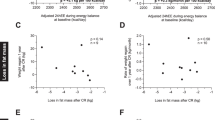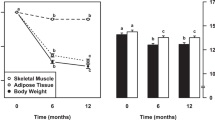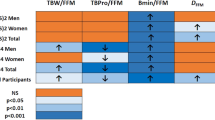Abstract
Objective:
We investigated to what extent changes in metabolic rate and composition of weight loss explained the less-than-expected weight loss in obese men and women during a diet-plus-exercise intervention.
Design:
In all, 16 obese men and women (41±9 years; body mass index (BMI) 39±6 kg m−2) were investigated in energy balance before, after and twice during a 12-week very-low-energy diet(565–650 kcal per day) plus exercise (aerobic plus resistance training) intervention. The relative energy deficit (EDef) from baseline requirements was severe (74%–87%). Body composition was measured by deuterium dilution and dual energy X-ray absorptiometry, and resting metabolic rate (RMR) was measured by indirect calorimetry. Fat mass (FM) and fat-free mass (FFM) were converted into energy equivalents using constants 9.45 kcal per g FM and 1.13 kcal per g FFM. Predicted weight loss was calculated from the EDef using the ′7700 kcal kg−1 rule′.
Results:
Changes in weight (−18.6±5.0 kg), FM (−15.5±4.3 kg) and FFM (−3.1±1.9 kg) did not differ between genders. Measured weight loss was on average 67% of the predicted value, but ranged from 39% to 94%. Relative EDef was correlated with the decrease in RMR (R=0.70, P<0.01), and the decrease in RMR correlated with the difference between actual and expected weight loss (R=0.51, P<0.01). Changes in metabolic rate explained on average 67% of the less-than-expected weight loss, and variability in the proportion of weight lost as FM accounted for a further 5%. On average, after adjustment for changes in metabolic rate and body composition of weight lost, actual weight loss reached 90% of the predicted values.
Conclusion:
Although weight loss was 33% lower than predicted at baseline from standard energy equivalents, the majority of this differential was explained by physiological variables. Although lower-than-expected weight loss is often attributed to incomplete adherence to prescribed interventions, the influence of baseline calculation errors and metabolic downregulation should not be discounted.
This is a preview of subscription content, access via your institution
Access options
Subscribe to this journal
Receive 12 print issues and online access
$259.00 per year
only $21.58 per issue
Buy this article
- Purchase on Springer Link
- Instant access to full article PDF
Prices may be subject to local taxes which are calculated during checkout



Similar content being viewed by others
References
Wishnofsky M . Caloric equivalents of gained or lost weight. Am J Clin Nutr 1958; 6: 542–546.
Del Corral P, Chandler-Laney PC, Casazza K, Gower BA, Hunter GR . Effect of dietary adherence with or without exercise on weight loss: a mechanistic approach to a global problem. J Clin Endocrinol Metab 2009; 94: 1602–1607.
Goele K, Bosy-Westphal A, Rumcker B, Lagerpusch M, Muller MJ . Influence of changes in body composition and adaptive thermogenesis on the difference between measured and predicted weight loss in obese women. Obesity Facts 2009; 2: 105–109.
Heymsfield SB, Harp JB, Reitman ML, Beetsch JW, Schoeller DA, Erondu N et al. Why do obese patients not lose more weight when treated with low-calorie diets? A mechanistic perspective. Am J Clin Nutr 2007; 85: 346–354.
Suarez R . The biology of energy expenditure. J Exp Biol 2011; 214: 163.
Ahima RS, Prabakaran D, Mantzoros C, Qu D, Lowell B, Maratos-Flier E et al. Role of leptin in the neuroendocrine response to fasting. Nature 1996; 382: 250–252.
Capel F, Viguerie N, Vega N, Dejean S, Arner P, Klimcakova E et al. Contribution of energy restriction and macronutrient composition to changes in adipose tissue gene expression during dietary weight-loss programs in obese women. J Clin Endocrinol Metab 2008; 93: 4315–4322.
Danforth E . The role of thyroid hormones and insulin in the regulation of energy metabolism. Am J Clin Nutr 1983; 38: 1006–1017.
Friedl KE, Moore RJ, Hoyt RW, Marchitelli LJ, Martinez-Lopez LE, Askew EW . Endocrine markers of semistarvation in healthy lean men in a multistressor environment. J Appl Physiol 2000; 88: 1820–1830.
Rosenbaum M, Hirsch J, Murphy E, Leibel RL . Effects of changes in body weight on carbohydrate metabolism, catecholamine excretion, and thyroid function. Am J Clin Nutr 2000; 71: 1421–1432.
Weyer C, Pratley RE, Salbe AD, Bogardus C, Ravussin E, Tataranni PA . Energy expenditure, fat oxidation, and body weight regulation: a study of metabolic adaptation to long- term weight change. J Clin Endocrinol Metab 2000; 85: 1087–1094.
Hall KD, Jordan PN . Modeling weight-loss maintenance to help prevent body weight regain. Am J Clin Nutr 2008; 88: 1495–1503.
Flatt JP . Exaggerated claim about adaptive thermogenesis. Int J Obes 2007; 31: 1626–1626.
Major GC, Doucet E, Trayhurn P, Astrup A, Tremblay A . Clinical significance of adaptive thermogenesis. Int J Obes 2007; 31: 204–212.
Rosenbaum M, Leibel RL . Reply to R Weinsier et al. Am J Clin Nutr 2001; 73: 657–658.
Weinsier RL, Nagy TR, Hunter GR, Darnell BE, Hensrud DD, Weiss HL . Do adaptive changes in metabolic rate favor weight regain in weight-reduced individuals? An examination of the set-point theory. Am J Clin Nutr 2000; 72: 1088–1094.
Grande F, Anderson JT, Keys A . Changes of basal metabolic rate in man in semistarvation and refeeding. J Appl Physiol 1958; 12: 230–238.
James WPT, Shetty PS . Matabolic adaptation and energy requirements in developing countries. Hum Nutr: Clin Nutr 1982; 36: 331–336.
Keys A, Brozek J, Henschel A, Mickelson O, Taylor H . The Biology of Human Starvation. University of Minnesota Press: St Paul, 1950. pp 303–339.
Del Corral P, Bryan DR, Garvey WT, Gower BA, Hunter GR . Dietary adherence during weight loss predicts weight regain. Obesity 2011; 19: 1177–1181.
Secor S . Specific dynamic action: a review of the postprandial metabolic response. J Comp Physiol B 2009; 179: 1–56.
Byrne NM, Hills AP . Relationships between HR and VO2 in the obese. Med Sci Sports Exerc 2002; 34: 1419–1427.
Colley RC, Hills AP, O′Moore-Sullivan TM, Hickman IJ, Prins JB, Byrne NM . Variability in adherence to an unsupervised exercise prescription in obese women. Int J Obes 2008; 32: 837–844.
Colley RC, Byrne NM, Hills AP . Implications of the variability in time to isotopic equilibrium in the deuterium dilution technique. Eur J Clin Nutr 2007; 61: 1250–1255.
Roffey DM, Byrne NM, Hills AP . Day-to-Day variance in measurement of resting metabolic rate using ventilated-hood and mouthpiece & nose-clip indirect calorimetry systems. JPEN J Parenter Enteral Nutr 2006; 30: 426–432.
Weir JBD . New methods for calculating metabolic rate with special reference to protein metabolism. J Physiol (London) 1949; 109: 1–9.
Wood RE, Byrne NM, Groves AM, Hills AP, King NK . Achieving energy balance in apparently sedentary obese males. Obesity Reviews 2010; 11: 219.
Haddock BL, Wilkin LD . Resistance training volume and post exercise energy expenditure. Int J Sports Med 2006; 27: 143–148.
Hunter GR, Wetzstein CJ, Fields DA, Brown A, Bamman MM . Resistance training increases total energy expenditure and free-living physical activity in older adults. J Appl Physiol 2000; 89: 977–984.
Melanson EL, Sharp TA, Seagle HM, Donahoo WT, Grunwald GK, Peters JC et al. Resistance and aerobic exercise have similar effects on 24-h nutrient oxidation. Med Sci Sports Exerc 2002; 34: 1793–1800.
Forbes GB . Human body composition. Springer Verlag: New York, 1987.
Spady DW, Payne PR, Picou D, Waterlow JC . Energy balance during recovery from malnutrition. Am J Clin Nutr 1976; 29: 1073–1088.
Alpert S . A two-reservoir energy model of the human body. Am J Clin Nutr 1979; 32: 1710–1718.
Hoyt RW, Opstad PK, Haugen A-H, DeLany JP, Cymerman A, Friedl KE . Negative energy balance in male and female rangers: effects of 7 d of sustained exercise and food deprivation. Am J Clin Nutr 2006; 83: 1068–1075.
Bray G . Effect of caloric restriction on energy expenditure in obese patients. Lancet 1969; 294: 397–398.
Franck N, Gummesson A, Jernas M, Glad C, Svensson P-A, Guillot G et al. Identification of adipocyte genes regulated by caloric intake. J Clin Endocrinol Metab 2011; 96: E413–E418.
Piers L, Soares M, Shetty P . Thermic effect of a meal. 2. Role in chronic undernutrition. Br J Nutr 1992; 67: 177–185.
Byrne NM, Groves AM, McIntyre HD, Callaway LK, group ftB. Changes in resting and walking energy expenditure and walking speed during pregnancy in obese women. Am J Clin Nutr 2011; 94: 819–830.
Colley RC, Hills AP, King NA, Byrne NM . Exercise-induced energy expenditure: implications for exercise prescription and obesity. Patient Educ Couns 2010; 79: 327–332.
King NA, Caudwell P, Hopkins M, Byrne NM, Colley RC, Hills AP et al. Metabolic and behavioral compensatory responses to exercise interventions: barriers to weight loss. Obesity 2007; 15: 1373–1383.
Martin C, Heilbronn L, de Jonge L, DeLany J, Volaufova J, Anton S et al. Effect of calorie restriction on resting metabolic rate and spontaneous physical activity. Obesity 2007; 15: 2964–2973.
Vaanholt LM, Magee V, Speakman JR . Factors predicting individual variability in diet-induced weight loss in MF1 mice. Obesity 2012; 20: 285–294.
Author information
Authors and Affiliations
Corresponding author
Ethics declarations
Competing interests
The authors declare no conflict of interest.
Rights and permissions
About this article
Cite this article
Byrne, N., Wood, R., Schutz, Y. et al. Does metabolic compensation explain the majority of less-than-expected weight loss in obese adults during a short-term severe diet and exercise intervention?. Int J Obes 36, 1472–1478 (2012). https://doi.org/10.1038/ijo.2012.109
Received:
Revised:
Accepted:
Published:
Issue Date:
DOI: https://doi.org/10.1038/ijo.2012.109
Keywords
This article is cited by
-
Tissue losses and metabolic adaptations both contribute to the reduction in resting metabolic rate following weight loss
International Journal of Obesity (2022)
-
Predictive Mathematical Models of Weight Loss
Current Diabetes Reports (2019)
-
Intermittent energy restriction improves weight loss efficiency in obese men: the MATADOR study
International Journal of Obesity (2018)
-
Less-than-expected weight loss in normal-weight women undergoing caloric restriction and exercise is accompanied by preservation of fat-free mass and metabolic adaptations
European Journal of Clinical Nutrition (2017)
-
Effect of Exercise Training on Non-Exercise Physical Activity: A Systematic Review and Meta-Analysis of Randomized Controlled Trials
Sports Medicine (2017)



